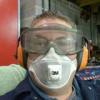To get the diaphragm to sit flat on my Borg & Beck clutch when it's all bolted up I need to skim 40 thou off of the pressure plate horns.
I was going to get a little more skimmed off so as the clutch linings wear the diaphragm returns to the flat position thus increasing the clamping force.
The question is how much extra to skim from the horns in addition to the 40 thou?
The distance between the surface of the lining and the rivets is 40 thou. If the clutch was half worn the friction disc would reduce in thickness by 40 thou.
Should I get an additional 40 thou skimmed from the pressure plate horns (total 80 thou) so when the clutch is half worn the pressure plate is then flat?



















